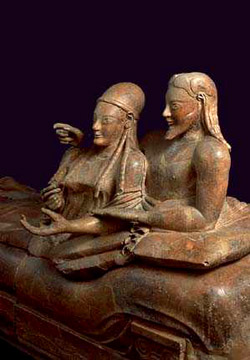|
|
Apartments in Florence, Perugia, Rome, Sorrento and Positano |




|
|
|
|
- You are in: Home » musei » VILLA GIULIA - Rome
VILLA GIULIA - Rome

Villa Giulia was built by Pope Julius III, on what was then the edge of the city, in 1550–1555. Today it is publicly owned, and houses the Museo Nazionale Etrusco an impressive collection of Etruscan art and artifacts. The villa was built in an area of Rome known as the 'Vigna Vecchia', lying on the slopes of Monte Parioli, as a 'Villa Suburbana' and a place of repose.
The pope - an affable, deeply literate connoisseur of arts - assigned the design of the building to Giacomo Barozzi da Vignola in 1551-1553. However, the nymphaeum and other garden structures were designed by Bartolomeo Ammanati, all under the watchful supervision of Giorgio Vasari. Michelangelo worked there too. The Pope offered direct guidance himself; Julius spent vast amounts of money enhancing the beauty of the villa, which became one of the most delicate examples of Mannerist architecture.
What survives of the villa is only a small part of the original property, comprising three vineyards that extended down to the Tiber, and to which the pope traveled often by boat. Like all suburban villas, the villa had an urban entrance (on the Roman Via Flaminia) and a formal but rural garden behind. The Villa itself was a threshold between two worlds, an essentially Roman conception that was adopted in every urbane culture of Western Europe. A medal struck in 1553 shows the villa substantially as completed, but with a pair of cupolas that were never executed.
Vignola's urban front of the building is a sombre two storey facade, each storey given equal value. It has at its centre the triple rhythm of a richly detailed rusticated triumphal arch flanked by symmetrical wings of two bays only. The facade is terminated at each end by Doric pilasters. In this facade of the Villa Giulia is the germ-idea of the seven-bay 18th century Georgian villa, which was reproduced as far away as the Tidewater region of Virginia. The rear of the building has Ammanati's large hemispherical loggia overlooking the first of three courtyards, laid out as a simple parterre. At its rear the visitor passes through the casina, which again has a hemispherical rear facade, enclosing paired flights of re-entrant marble steps that give access to the heart of the villa complex - a two-storey Nympheum for alfresco dining during the heat of the summer.
This three-levelled structure of covered loggias, decorated with marble statuary, reclining river gods in niches, and balustrading, is constructed around a central fountain: here in this cool environment, sheltered from the blazing sun, day long picnics would be held. The central fountain, Fontana dell'Acqua Vergine, was designed and sculpted by Vasari and Ammannati: it depicts river gods and caryatids. The fountain's source, the Acqua Vergine, also supplies the Trevi Fountain in Rome.
The Casino della Vigna ("little house in the vineyard"), as it was sometimes known, and its gardens were set in the midst of vineyards, which could be viewed from shaded arcades on the outsides of the garden walls. Papal parties embarked on a boats at the gates of The Vatican and were transported up the Tiber to the villa's long-gone private landing stage.
Following Pope Julius's death, his successor Pope Paul IV confiscated all the properties he had assembled; the villa was divided, the main building and part of the gardens became the property of the Camera apostolica. The Villa was reserved for the use of the new pope's Borromeo nephews. It was restored in 1769 on the initiative of Pope Clement XIV, confiscated by the new state of Italy in 1870, and given over to the National Etruscan Museum in the early 20th century.
museums archive
|
|
|
|
|
|
| TOP DESTINATIONS
|
| Adria Coast, Aeolian Islands, Alessandria, Altopiano Delle Rocche, Amalfi Coast, Aosta, Assisi, Asti, Bari, Brescia, Capo Vaticano, Capri, Catanzaro, Chianti, Cilento, Cinque Terre, Coast Of Marche, Conero Coast, Dolomites, Egadi Islands, Elba, Florence, Garda Lake, Gargano, Ischia, Italian Riviera, Lake Como , Langhe Piedmont, Lecce, Lucca, Lunigiana, Macerata, Mantova, Maremma Tuscany, Monferrato, Montepulciano, Naples, Perugia, Pesaro Urbino, Pisa, Pistoia, Positano, Prato, Procida, Riviera Of Palms, Rome, Salento Coast, Salerno, San Gimignano, Sardinia, Sicily, Siena, Sorrento, Terni, Tiber Valley Of Tuscany, Treviso, Turin, Val Gandino, Veneto, Venice, Viterbo |
|
|





